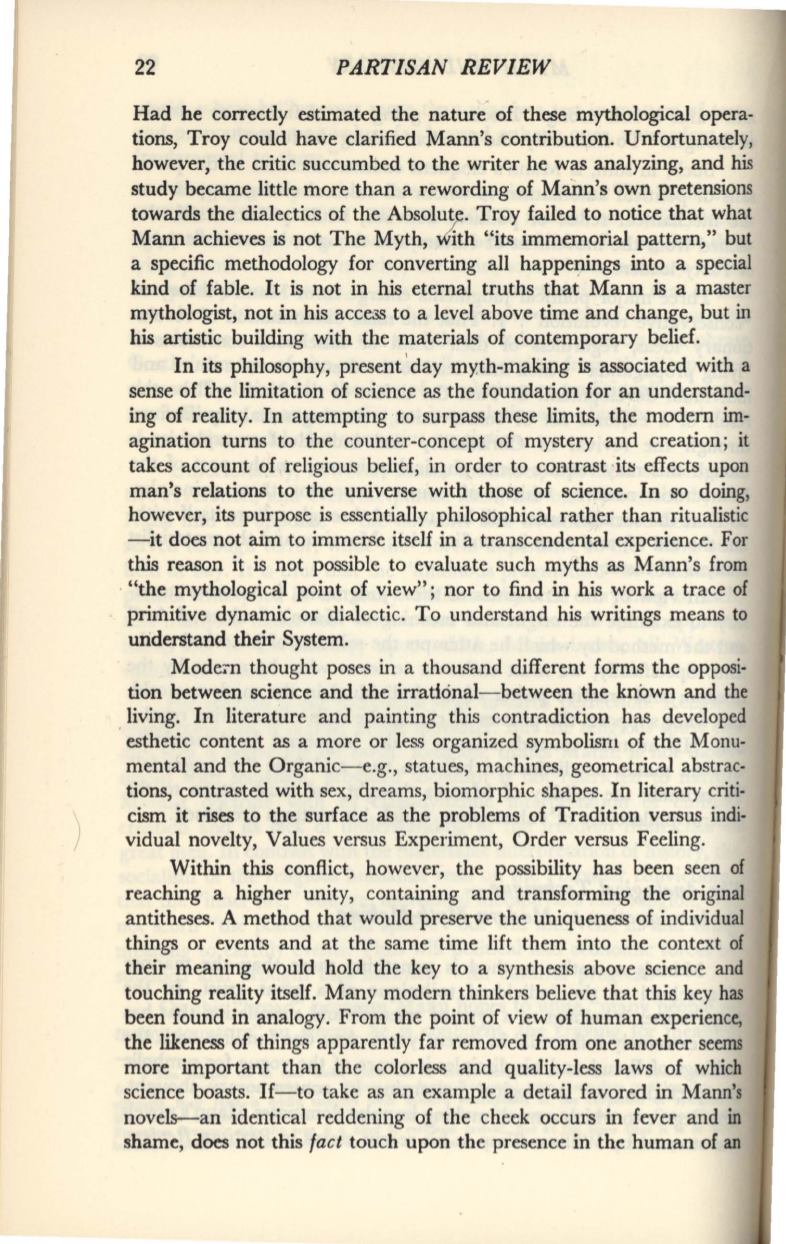
22
PARTISAN REVIEW
Had he correctly estimated the nature of these mythological opera–
tions, Troy could have clarified Mann's contribution. Unfortunately,
however, the critic succumbed to the writer he was analyzing, and
his
study became little more than a rewording of Maim's own pretensions
towards
th~ dial~ctics
of the Absolutf"
T~oy
.failed to
~otice
that what
Mann achieves
1S
not The Myth, with "Its rmmemonal pattern," but
a specific methodology for converting all happe.J?ings into a special
kind of fable. It is not in his eternal truths that Mann is a master
mythologist, not in his acce.>S to a level above time and change, but in
his artistic building with the materials of contemporary belief.
In its philosophy, present 'day myth-making is associated with a
sense of the limitation of science as the foundation for an understand–
ing of reality. In attempting to surpass these limits, the modern
im–
agination turns to the counter-concept of mystery and creation; it
takes account of religious belief, in order to contrast ·its effects upon
man's relations to the universe with those of science. In so doing,
however, its purpose is essentially philosophical rather than ritualistic
-it does not aim to immerse itself in a transcendental experience. For
this reason it is not possible to evaluate such myths as Mann's from
· "the mythological point of view"; nor to find in his work a trace of
primitive dynamic or dialectic. To understand his writings means to
understand their System.
Mode~n
thought poses in a thousand different forms the opposi–
tion between science and the irrational-between the known and the
. living. In literature and painting this contradiction has developed
esthetic content as a more or less organized symbolism of the Monu–
mental and the Organic- e.g., statues, machines, geometrical abstrac–
tions, contrasted with sex, dreams, biomorphic shapes. In literary criti–
cism it rises to the surface as the problems of Tradition versus indi–
vidual novelty, Values versus Experiment, Order versus Feeling.
Within this conflict, however, the possibility has been seen of
reaching a higher unity, containing and transforming the original
antitheses. A method that would preserve the uniqueness of individual
things or events and at the same time lift them into the context of
their meaning would hold the key to a synthesis above science and
touching reality itself. Many modern thinkers believe that this key has
been found in analogy. From the point of view of human experience,
the likeness of things apparently far removed from one another seems
more important than the colorless and quality-less laws of which
science boasts. If-to take as an example a detail favored in Mann's
novels--an identical reddening of the cheek occurs in fever and
in
shame, does not this
fact
touch upon the presence in the human of
an


